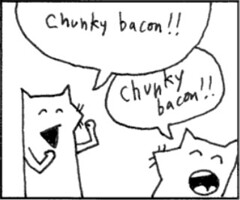Chunky Data & HTML5

Anyone familiar with Ruby should be familiar with Why's Poignant Guide to Ruby, a satisfyingly leftfield guide, to Ruby. It features foxes, Blix the cat and a pet ham.

Insistent foxes © Why's Poignant Guide to Ruby
It also features Chunky Bacon, a blatant (and succesful) attempt by the fox characters to influence the narrative of the book.
Chunky Bacon has gotten me thinking about Chunky Data. Content Strategy has thankfully taken centre stage, thanks to such elqouent luminaries as Karen McGrane.
Let's be honest, users are selfish creatures. They only care about themselves and what's in it for them. They don't give a damn about your website, they only visit you for your content.
Which is why it's good to think of your content in chunks, not pages. Pages are an abstraction, whereas collections of chunky data are an attraction. And this segueways nicely into HTML5.
Because mulitple h1 headings are allowed on the same page, and are hierarchically organised by context such as aside, this means your chunks of data can exist intact, whether they are a standalone article or a snippet in an aside to an associated article. No more marking up for different locations, hurrah! Or to put it another way:
Markup once, use many times